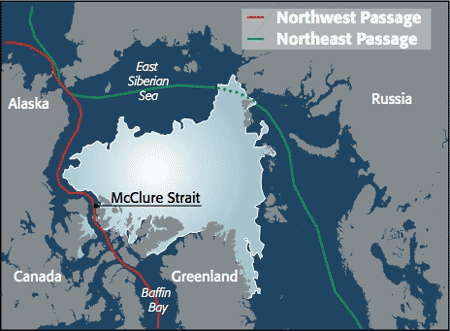
Two German freighters have successfully navigated the Northeast Passage, a feat that has long eluded explorers. Why does it matter? Simon Wilson reports.
Why is the Arctic in the news?
Two German-owned freighters, the Beluga Fraternity and the Beluga Foresight, have in recent weeks successfully navigated the Northeast Passage, sailing from Asia to Europe round the top of Siberian Russia – a feat that eluded explorers for centuries.
In the 16th century, two celebrated English sailors, Richard Chancellor and Hugh Willoughby, made doomed efforts to find a north-eastern route from Europe to the East Indies. T he two men met rather different fates. In 1553, Chancellor abandoned ship in the ice, and marched to Moscow, where he was feted at the court of Ivan the Terrible. Willoughby, by contrast, froze to death – as did Dutch explorer William Barents, after whom the polar sea is named.
The success of the German ships in pulling off what appears to be the first commercial navigation is a highly visible symbol of the ongoing jostling for position over claims to the Arctic and its potential riches as the planet warms.
So is the route now commercially viable?
Not exactly. The Russian Transport Ministry, which operates a fleet of six nuclear-powered ice-breakers to assist commercial shipping, says the route has rarely been completely impassable in recent summers.
But the ice-breakers are still very much needed. Despite global warming, ships attempting the Northeast Passage have to contend with hundred-mile long swathes of shifting pack ice, even during the two months or so each summer when safe passage is feasible.
The Belugas are specially reinforced ships, but each needed permanent support from at least one of the ice-breakers. And at the route’s northernmost point, the Vilkizi strait at the tip of Siberia, both ships had to call ice pilots on board to guide them through the ice.
Sounds daunting?
Quite – and not necessarily much cheaper. The Belugas’ journey from South Korea to the Netherlands is about 11,000 nautical miles (12,658 miles). In theory, that shaves around 3,000 nautical miles (3,452 miles) and ten days off the traditional route via the Suez canal, resulting in lower costs. The German shipping company behind the voyage, also called Beluga, claims it has saved $300,000 per ship.
But the extra costs of ice-breakers, the unpredictability of the route, and the fact that it will only be passable for a couple of months a year, mean that the commercial benefits look patchy.
Hardcore climate-change deniers (notably Christopher Booker of The Daily Telegraph) insist that the Beluga voyage is little more than a ‘warmist’ PR stunt, and point out that Russia has long used its northern coast for shipping fuel, supplies and other goods to its remote Arctic settlements (although funding for these has dwindled since the Soviet era).
Is Booker right?
There’s no doubt that Beluga is looking to win new business. But there’s also no doubt that the voyage is a further piece of evidence that climate change is real. Climate scientists are certain that the Arctic is warming: this year is set to have the third-lowest amount of Arctic sea ice on record, just behind the two worst years ever – 2007 and 2008.
What this does mean for commercial shipping is that for the past few years the Northwest Passage across the top of Canada (far more commercially attractive than the Russian route) has been navigable. Then in 2007, the even more crucial deepwater channel called M’Clure Strait opened.
“We are seeing an expression of climate change here,” says Mark Serreze, director of the National Snow and Ice Data Center in Boulder, Colorado. “The Arctic is warming; we’re losing the sea ice cover. The more frequent opening of that Northeast Passage is part of the process we’re seeing.”
What does a warmer Arctic mean?
Along with faster and cheaper shipping between Europe and east Asia, the thinning ice cap means that the frozen north’s vast resources of oil and gas are potentially accessible for the first time.
Estimates vary wildly, but a top-end guess (by the US Geological Survey in 2000) is that 25% of the world’s remaining oil reserves could lie beneath the Arctic ice cap and 30% of its gas. Lying deep under a frozen North Pole, these resources will clearly be extremely hard and expensive to extract, but improving technology and a high oil price make exploitation viable – if not quite yet, then in the medium term.
That said, some climate scientists now believe that the Arctic could be ice-free as soon as 2013. For that reason, political tensions have been rising in recent years, as the polar powers – Russia, Canada, the US (Alaska), Denmark (Greenland) and Norway jockey for position over who owns what in the high north.
Could the battle for the Arctic get hot?
The main tension is between Russia and Canada, who both claim that the Lomonosov Ridge, an underwater mountain range under the North Pole, is an extension of their respective continental shelves. But although Russia and Nato have upped the rhetoric and military activity a little this year, the likelihood of armed conflict in the high north is remote.
First, four of the five powers involved are Nato allies. Second, most of the promising oil and gas fields are within established and recognised national economic zones. Third, last year all five (including the most assertive, Russia) reiterated a commitment to the resolution of conflicts through existing customary law, notably the UN Convention on the Law of the Sea.